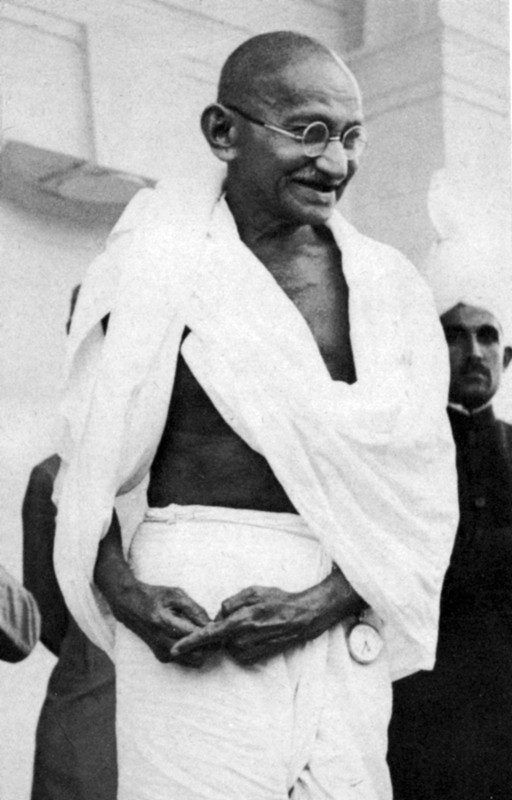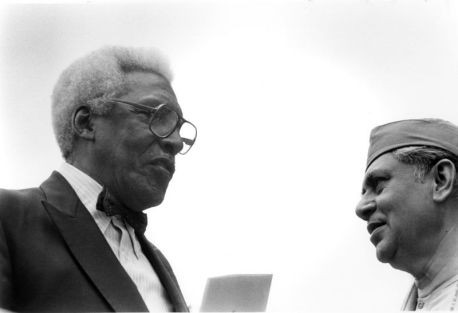Mohandas Gandhi Statue
Introduction
Text-to-speech Audio
Images
Mohandas Gandhi Statue
.jpg)
Mohandas Gandhi (1869-1948)

Bayard Rustin (left) at the unveiling ceremony in 1986

Backstory and Context
Text-to-speech Audio
Mohandas Karamchand Gandhi (known also as Mahatma Gandhi) was born to a well-to-do family in the city of Porbandar in British India on October 2, 1869. At the age of eighteen, he went to England to pursue legal studies. After completing his law degree, Gandhi returned to his homeland in 1891 with the hope of putting his legal training to use. After years of struggling to find a job, he finally accepted a temporary position in South Africa in 1893. Gandhi’s time there proved to be an eye-opening and influential period in his life. While living in South Africa, the young Indian lawyer experienced firsthand the overt racism and discriminatory laws directed toward non-whites. On one occasion, which he later referred to as a watershed in his life, Gandhi was kicked off a train after refusing to leave a first-class, whites-only passenger car and move to another compartment. While spending the night in the freezing cold waiting room of the train station at Pietermaritzburg, he decided to devote himself to fighting injustice. In the following years, Gandhi moved to organize the minority Indian community in South Africa. It was during this time that he also developed his philosophy of nonviolent civil disobedience. Gandhi’s social activism kept him in South Africa until 1914, when he returned to India.
From 1919 to 1948, Gandhi peacefully protested the injustices suffered by Indians under the British Raj. After British authorities issued laws that allowed for Indians suspected of sedition to be jailed without trial, he called for a national day of fasting and a work stoppage. In 1930, Gandhi led a 200-mile march to the coast, where he and others made salt from seawater in defiance of a British law that forbade Indians from manufacturing salt. Taxes on salt helped to fund the British colonial government. Gandhi’s actions inspired tens of thousands of Indians to do the same in protest. In the 1940s, he went on a hunger strike to protest the treatment of India’s “untouchables.” This led to a 1947 resolution that made it illegal to discriminate against that particular caste of persons. During this period, most significantly, Gandhi called for an end to British rule in India, becoming the leader of the Indian independence movement. He also worked assiduously to promote peace and understanding between Hindus and Muslims. Indian independence from Great Britain finally came in 1947, but religious strife between Hindus and Muslims continued. The following year, on January 30, while on his way to a prayer meeting in New Delhi, Gandhi was assassinated by a Hindu extremist angered by Gandhi’s cooperation with, and tolerance for, Muslims.
On October 2, 1986, a statue of Gandhi was dedicated in Union Square Park. Sponsored by the Gandhi Memorial International Foundation with support from Indian-born fashion tycoon Mohan Murjani, the over-life-sized bronze statue depicts Gandhi walking with a staff, peering into the distance. Designed by sculptor Kantilal B. Patel, it was installed in Union Square Park because of the park’s long history as a site of demonstrations and protests. Civil rights and gay rights activist Bayard Rustin delivered the keynote address during the unveiling ceremony. Today, the statue remains in its original location near the southwest corner of Union Square Park.
Cite This Entry
Tanner, Michael and Francis Curran. "Mohandas Gandhi Statue." Clio: Your Guide to History. January 7, 2021. Accessed April 17, 2025. https://theclio.com/tour/104/2
Sources
"Gandhi, Mohandas K." The Martin Luther King, Jr. Research and Education Institute. Stanford University. Web. 6 January 2021 <https://kinginstitute.stanford.edu/encyclopedia/gandhi-mohandas-k>.
History.com Editors. "Mahatma Gandhi." History. A&E Television Networks. 6 June 2019. Web. 6 January 2021 <https://www.history.com/topics/india/mahatma-gandhi>.
Leonard, Thomas M., ed. Encyclopedia of the Developing World. Vol. 2, F-N. New York: Routledge, 2006.
"Mohandas Gandhi." New York City Department of Parks and Recreation. The City of New York. Web. 6 January 2021 <https://www.nycgovparks.org/parks/union-square-park/highlights/12380>.
http://daytoninmanhattan.blogspot.com/2017/11/the-mohandas-gandhi-statue-union-square.html
https://www.britannica.com/biography/Mahatma-Gandhi
https://www.britannica.com/biography/Mahatma-Gandhi

